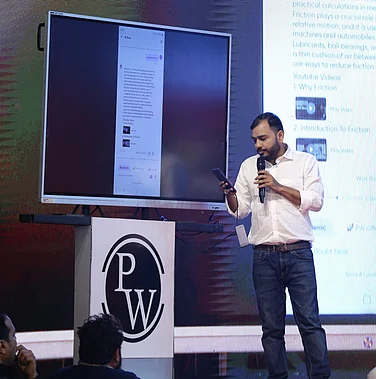Incorporating big data analytics and content management, educators can develop an individualised curriculum that enhances how each student learns (e.g. playlist of learning content in WiseWire changing for each student). Many in the West have started the use of the millennials’ language and style like Khan Academy video lessons, YouTube use, distinct style and language for young learners. Twitter, Tumblr, Snapchat, Imessage, Instagram, Facebook and Whatsapp are being creatively integrated with school education. There is a case of a management school in India, where the professor sends a 3 minutes interesting video on the subject he is taking up next through group Whatsapp to increase interest in the batch towards the topic being taught.
Advertisement
In the US, smartphone applications like Socrative and Plickers are helping teachers interact and assess students’ progress, collaborate via cloud-based applications to work and solve a common goal. Teachers can publish real-time quizzes and polls for students via mobile devices to keep them engaged.
Further, using anything from iMovie to WeVideo, learners can create a video as a learning resource. YouTube (with privacy settings) and SeeSaw or Flipgrid are also alternatives learners can make use of. The benefits of SeeSaw and Flipgrid are that students can add voice recordings or text sharing feedback with peers. Students became the co-creators of content and as a result, more engaged, including their parents. Useful apps like Book Creator, Explain Everything and EduCreations can be utilised towards this end.
Advertisement
There are many softwares to create digital content, like Camtasia, Raptivity, Captivate, Articulate Online.
Yes alongside, social media use extensively will support learning online. Facebook Page can broadcast updates and alerts. Facebook Group or Google Hangout with advanced features in G-suite can stream live lectures and host discussions. Twitter can act as a class message board. The 256 characters help to keep messages succinct. Instagram can be used for photo essays. One can create a class blog for discussions. There are many different platforms available, such as WordPress, SquareSpace, Wix, Blogger that. And, one can create a class-specific Pinterest board as well.
Students to Learners
With mentors replacing teachers, the students cannot be the pre-Covid typical students anymore going ahead.
Students study in the classroom, are taught by teachers, are limited to the given syllabus, and study for marks, grades, degrees. Students give exams in writing and on the basis of suggestions or set patterns of evaluation.
Learners study within and beyond the classroom, from mentors, peers, personal experience, books, digitally aggregated content, through projects and through assignments. Learners learn for lifetime application, and hence learn to learn further as things learnt today are obsolete soon. Self-learning or learning to learn is hence a major cultivated skill for the present-day learners, especially in higher education, as techniques and technologies are changing in the workplace in less than five years now. Learners also learn organically. While a structured syllabus must be completed for foundation and examination, organic learning is about self-driven learning in a few chosen areas out of interest, assisted by the mentors.
Advertisement
Yes, for this, doubling public education expenditure, digital access to the hinterland, considering digital connectivity as a human right, digital literacy as a fundamental prerequisite in any work, providing cell phones and laptops or tablets en masse, announcing cheaper data packages for students, CSR in the field of the domain of digital connectivity by corporate houses, and more would be needed soonest to bridge the yawning digital divide in the otherwise class-divided society. According to UNESCO, only 48 per cent of the Indian learners’ community of 283 million is receiving some sort of online education today, the rest 52 per cent going bereft of any form of formal learning whatsoever for more than a year now! And among these 48 per cent, the girl-students are having a worse fate in the poorer families due to limited digital devices to which the sons have higher access than the daughters.
Advertisement
Conclusion
India has been speaking of digital education for a long but it has stayed on as a possibility and not a reality for more than a decade now. Even IITs and IIMs have used digital platforms on the side for sharing content and debating on issues sporadically. The larger mass of 900 plus universities and some 44,000 colleges have actually not digitised their content, not made access to online learning a mainstay of their teaching-learning process, except the distance learning universities. In fact, the old school educationists looked at online and distance education with some disdain all across South Asia. They are in for a major shock now. The digital divide needs fast bridging through the promise of 6 per cent of the GDP for public education, through 2 per cent of profits for CSR given here, and through civil society initiatives like getting smartphones, laptops, and tabs for the less privileged.
Advertisement
It is clear that going ahead with digital access will be a human right, and those in governance must wake up to the reality that youngsters need inexpensive tablets and easy data access. A nation that spends less than 3 per cent of the national budget for public education (lower than Tanzania, Angola, and Ghana, et al), with the states putting in 2.5 (Bihar) to 26 per cent (Delhi), with Delhi being the only state in double digits, cannot ensure digital education for the masses, unless allocation of funds and their transparent spending happen.
[concluded]
Advertisement
The author is the Pro-Vice-Chancellor of Adamas University, and earlier the Media Dean of Symbiosis and Amity Universities
DISCLAIMER: Views expressed are the author’s own, and Outlook Money does not necessarily subscribe to them. Outlook Money shall not be responsible for any damage caused to any person/organisation directly or indirectly.















 Just one email a week
Just one email a week